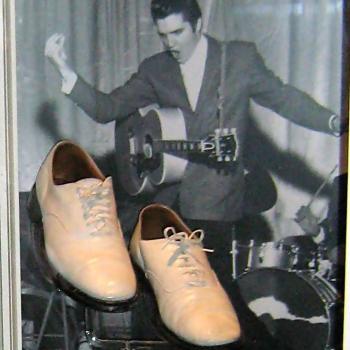I have a lot of small thoughts about this piece at The Fix about the similarities and differences between cognitive behavioral therapy and the 12 Steps. I don’t know that these small thoughts come together into one big Voltron thought, so I will just put them out there in a list. As always, my opinions are worth exactly what you paid for them.
First, although this post will focus on what’s left out of the article, I want to make clear that I’m basically pro-CBT and I know several people who have really been helped by it.
Also, if you don’t think this piece makes a very good case that there are useful parallels between CBT and AA, you might be interested in Recovery Options (which I’ve praised before), in which Maia Szalavitz sets out a thoughtful, balanced account of the two approaches’ similarities for addiction recovery. RO does better than this article does, I think, in part because this article is framed as, “The 12 Steps are the primitive leech-using version of the real, scientific method of CBT,” which is… false, since the 12 Steps are doing a related-but-different thing. But the negative vibe I’m getting from the Stein & Slaton piece may just be because Stein is not a great writer, which obviously isn’t Stein’s fault–it’s not her fault that her sections giving general theory of CBT sound like bureaucratese, whereas Slaton’s sections describing his working the 12 Steps sound ground-level and personal and real.
So okay, that’s where I’m coming from.
* One difference Stein & Slaton’s piece didn’t mention is that unlike cognitive behavioral therapy, Alcoholics Anonymous is free. They do not need to see your insurance card. You do not actually have to put your dollar in the basket. This is hugely important, I think, because along with the salutary effects of the growing push for professionalization of addiction treatment there’s also a really troubling effect in which free, communitarian “little platoons” are replaced by paid experts.
And AA works to turn sponsees into sponsors. It does have hierarchy–all human institutions do–but its hierarchy is much less rigid than the doctor-patient (or knower-known) hierarchy. You can actually see this in the illustration The Fix uses: In the first one it’s super obvious which guy is the addict and which guy is the analyst; in the second one it’s not clear who is sponsor and who is sponsee. In the first picture one guy is prone and the other is seated upright, while in the second they’re both on the same visual plane, presented as equals.
There are a few different and competing class angles here. First, obviously, it’s a lot easier to professionalize a service than to deliver that professional service free to those in need. And it’s easier to destroy or deplete a communal network of mutual aid than to replace it. If addiction treatment got entirely professionalized, I do not expect that would mean poor people received super great professional addiction treatment. I suspect they would just get no treatment. I don’t actually think this will happen, because AA is very resilient for a lot of reasons and is not about to just go away, but it might get marginalized and perhaps even stigmatized compared to “evidence-based treatments.” (Scare quotes are just because not everything can actually be studied, so evidence is not always the right criterion.) I wish professionalizers would be more up-front about the potential dangers and drawbacks of a shift in addiction treatment from primarily a mutual-aid model to primarily a service-provision(-often-for-fee) model.
That said, AA does not work well as an example of a Burkean “little platoon,” because it’s so thoroughly and controversially intertwined with government–if you can be court ordered into something, I’m gonna say that thing is not purely civil society anymore.
And AA is also not the best example of a mutual-aid network of the poor. There’s a lot of suspicion still in various poor communities toward AA, often because it’s not religious enough (lol, this is my problem with it too, or one of my problems). In Paul Fussell’s formulation, the upper class says, “Grandfather died.” The middle class says, “Grandma passed away.” The lower class says, “Uncle was taken to Jesus.” And AA is the middle one, not the last one.
So I don’t want to push the class-war angle too hard. But I do think money and class should have been mentioned in a piece contrasting a paid service with a free association.
* Where the parallels break down can be as interesting as where the two approaches match up. The God/Higher Power thing isn’t the only difference. There’s also a much stronger moral component to the 12 Steps, at least as presented here, and a much more explicit emphasis on penitence and forgiveness. I suspect this willingness to talk about making amends is one reason therapy never took on the huge cultural role Helen Rittelmeyer rightly identified for AA and addiction-recovery language.
Therapy has been around for a while and pop culture occasionally tries to make it hip or draw narrative from it (The Sopranos is maybe the most obvious example?) but it is definitely not as ubiquitous as 12-Step language, and I wonder if that’s because the makers of our pop culture really need a non-religious way to talk not about self-improvement but about release from the bondage of self. What the 12 Steps give you is a not-necessarily-religious way of talking about the moral life and about guilt, sin, penance, and forgiveness. They are the country music of addiction treatment! (…Wait, isn’t country music the country music of addiction treatment?)
CBT (I think) offers less of that, which is one reason it can do better than the 12 Steps for serving some people. I suspect CBT may be especially helpful for people who have been deeply hurt more than they’ve hurt others, who are more sinned-against than sinning, and who need to untangle damaging patterns of thought but don’t actually have a whole lot of amends to make–not more than the shocking average. Don’t get me wrong, those people still need Jesus, but only because everybody does.
Most of the people who make our pop culture are in many ways privileged (I mean, almost by definition, right?) and so AA’s chastening, humbling language speaks to their need to be taken down a few notches. It really speaks to me for the same reasons. But groups like Women for Sobriety have spoken eloquently about how different metaphors, of empowerment and liberation from addiction, are more necessary for less-privileged groups, who don’t need yet more reminders of their powerlessness. I suspect CBT works best for some people because its metaphors provide what they need.
Anyway, these are fairly half-formed thoughts, and if I didn’t think the hierarchy/class stuff was important I doubt I would have bothered to type them up. I welcome your comments, criticisms, etc etc etc; the email link is that flying envelope to your right!











